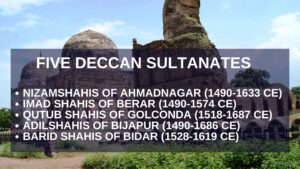The fall of the Yadavas and Kakatiyas to the Khaljis and Tughlaqs led to the establishment of several Muslim governorships in the Deccan region. Among the most significant events in Deccan history was the formation of the Bahmani Kingdom in 1347 by Ala-ud-Din Bahman Shah (Jafar Khan), marking the beginning of a new political and cultural era.
Establishment of the Bahmani Kingdom (1347-1525 CE)
The Bahmani Kingdom spanned modern-day Karnataka, Maharashtra, and Andhra Pradesh, with Ahsanabad (Gulbarga) as its capital. The Bahmanis were in continuous conflict with the Vijayanagar Empire, shaping the region’s political landscape.
Download notes of Delhi Sultanate: History, Dynasties, Contributions
Early Bahmani Rulers
- Hasan Gangu/Jafar Khan (1347 CE): Founded the Bahmani Sultanate and took the title of Abu’l-Muzaffar Ala-ud-din Bahman Shah. He divided his kingdom into four provinces—Gulbarga, Daulatabad, Berar, and Bidar—for efficient administration.
- Mohammed Shah I (1358-1375 CE): Engaged in prolonged wars with Warangal and Vijayanagar.
- Alauddin Mujahid (1375-1378 CE): Introduced the Afaqis (foreign nobles from Iraq and Iran) into his administration.
- Taj ud-Din Firuz Shah (1397-1422 CE): Expanded the kingdom, temporarily capturing the Raichur Doab from Vijayanagar. He promoted Deccan as a cultural hub and inducted Hindus into administration.
Mahmud Gawan and Administrative Reforms (1466-1481 CE)
Mahmud Gawan, an Iranian merchant, became the Prime Minister under Muhammad Shah III and was instrumental in the Bahmani Kingdom’s expansion and administration.
- Expanded the empire, capturing Kanchipuram, Goa, and Dabhol.
- Implemented administrative reforms by dividing the kingdom into eight provinces (tarafs).
- Built the Mahmud Gawan Madrasa in Bidar, reflecting Persian architectural influence.
- His execution in 1482 weakened the kingdom, leading to its fragmentation.
The Five Deccan Sultanates
Following the decline of the Bahmani Kingdom, five independent sultanates emerged:
- Nizamshahis of Ahmadnagar (1490-1633 CE): Founded by Ahmad Nizam Shah. Chand Bibi defended the kingdom against the Mughals, but it fell to Aurangzeb in 1636.
- Imad Shahis of Berar (1490-1574 CE): Founded by Fathullah Imad-ul-Mulk with its capital at Daulatabad. It was annexed by Ahmadnagar in 1574.
- Qutub Shahis of Golconda (1518-1687 CE): Founded by Muhammad Quli Qutb-ul-Mulk. Muhammad Quli Qutb Shah built the iconic Charminar. The kingdom was annexed by Aurangzeb in 1687.
- Adilshahis of Bijapur (1490-1686 CE): Founded by Yusuf Adil Shah. Muhammad Adil Shah constructed Gol Gumbaz, the second-largest dome in the world. Bijapur was annexed by Aurangzeb in 1686.
- Barid Shahis of Bidar (1528-1619 CE): Founded by Ali Barid, the smallest of the Deccan Sultanates. It was later annexed by the Adilshahis of Bijapur in 1619.

Administration of the Bahmani Kingdom
- Modeled after the Delhi Sultanate, the kingdom was divided into several tarafs.
- The nobility was divided into two factions: Afaqis (foreigners) and Deccanis (natives), leading to internal conflicts.
- Amir-Ul-Umara was the commander of the army, and the khassakhel were elite bodyguards of the Sultan.
Society and Culture
- The Bahmani Kingdom was a melting pot of ethnicities, including Hindus, Muslims, Iranians, and Abyssinians.
- Dakhini (proto-Urdu), Marathi, Kannada, and Telugu were widely spoken.
- Sufism played a significant role in Bahmani society.
- While some rulers were intolerant, others promoted Hindu-Muslim cultural harmony. For instance, Sultan Firuz Shah’s marriage to Deva Rai II’s daughter strengthened cultural ties.
Economy and Trade
- Mahmud Gawan’s land reforms increased state revenue.
- The Bahmani economy was heavily reliant on trade and commerce, with Bidar being a significant trade center.
- Nikitin, a Russian traveler, recorded that major trade goods included horses, silk, and spices. Dabul was a key port, connecting India to African and Middle Eastern markets.
Art and Architecture
- Indo-Islamic architecture, with Persian influences, flourished during the Bahmani period.
- Notable architectural marvels include:
- Mahmud Gawan Madrasa in Bidar
- Golconda Fort
- Gol Gumbaz in Bijapur (second-largest dome in the world)
- Charminar in Hyderabad
- Bidri Art, a metal craft from Bidar, developed under the Bahmani Sultanates, combining Persian and local influences.
Download notes of Vijayanagara Empire
Conclusion
The Bahmani Kingdom played a pivotal role in shaping Deccan history through its administrative innovations, cultural amalgamation, and Indo-Islamic architectural advancements. Although the empire eventually fragmented into the Deccan Sultanates and later fell to the Mughals, its legacy in art, architecture, and administration continues to influence South Indian history.
Understanding the Bahmani Kingdom is crucial for comprehending the broader history of medieval India, especially in terms of regional power dynamics, cultural syncretism, and the evolution of Indo-Islamic traditions.


